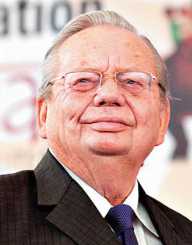By Shams Afif Siddiqi
People who meet people: Interviews with the stars
By Swapan K. Banerjee,
Tranquebar,
Rs 699
Scores of books about writers and their works have been published in the form of interviews. People like to listen to, or read about, the opinions of others, especially when they happen to be well known personalities. It bridges the gap between fame and anonymity. Even in this fast moving world, it is well nigh impossible for readers to not be affected by interviews. But few writers have taken the trouble to talk to musicians, filmmakers, dancers and other artists, and jot down their thoughts for the benefit of their fans. People Who Meet People is about interviews with “stars” from diverse fields. These legends talk about their art, methods of work and philosophy.
The book is a collection of 49 interviews of men and women from the world of art, dance, cinema and writing, some of whom are living legends. The foreword by I. Allan Sealy and introduction by Ruskin Bond (picture) are added attractions. What makes People Who Meet People significant is the coming together of famous names in a single volume. The common man cannot easily meet or talk to legends like the late Ustad Bismillah Khan or Ruskin Bond. But through this book, he can meet them and closely listen to their thoughts. Swapan K. Banerjee has managed to unravel the mysteries of these great people. He talked to them in the comfort of their homes. Among the writers and poets included in the book are Mulk Raj Anand, Khushwant Singh, Shiv. K. Kumar, Nayantara Sahgal, Nergis Dalal, Ruskin Bond, I. Allan Sealy, Bill Aitken, Hugh and Colleen Gantzer, Sudhir Thapliyal, Namita Gokhale, Amit Chaudhuri, Shobhaa De, Jayanta Mahapatra and so on. The book features famous musicians like Ustad Bismillah Khan, Pandit Jasraj, Pandit Bhajan Sopori, Kala Ramnath, Ustad Shahid Parvez and the singer, Kishori Amonkar. One will also find in this book people like the actor, Victor Banerjee, the renowned tiger expert, K. Ullas Karanth, and the documentary filmmaker, Neela Venkatraman. The book will thus appeal to all kinds of readers.
Although Banerjee does not make a distinction between writers and other artists, the book should have been divided into two parts to make it easier for readers. The parts that deal with musicians stray into a different world altogether. Ustad Bismillah Khan’s incredible mystical experiences touch the soul. The greater part of the book is taken up by poets and writers who have originally written in English. Some of them talk at length about their method and style of writing, which can be a boon for aspiring writers. Shiv. K. Kumar, who is always vocal, speaks at length about his methods, which can inspire new and even seasoned writers. Jayanta Mahapatra is reticent, but he too opens up easily to Banerjee. The interviewer manages to show how people from the world of art cultivate their craft and what it means to them. It is a rare peek into a world that is zealously guarded by the artists. Perhaps Banerjee’s persuasive manner broke the barriers between the artist and the ordinary man.
In the introduction to the book, Ruskin Bond calls Banerjee a ‘perfect listener.’ But the latter probably won the trust of the artists in more ways than one. One of them could be his extensive research on his subjects. While reading the conversations, readers slowly begin to identify with their icons, learn about their devotion and experiences in life. The book creates an impact on readers on two fronts. First, it portrays the artist and his art in a manner never seen before. Discerning readers know that once the artist creates something, his work assumes a life of its own; but when the same artist talks openly about his creation, he peels off layers to reach the heart of his own creative methods. It is this attempt at recreating the whole process that makes the reader marvel. Second, the interviewer’s method of drawing his subjects out attracts readers as much as the personalities in the book.
Although the people who have been interviewed are all different, Banerjee’s approach seems to be the same. There is neither an aggressive design nor a complex scheme in his method. But this does not mean that he has not done his homework. One is amazed to find how much material he handled in order to comfortably talk to the different people. He knows that artists are interested in talking about themselves and their art, so he makes no attempt to disturb their flow of thought.
But the readers do not know when the interviews were conducted. Banerjee’s introduction to the artists seems short and prosaic. A closer description of the artists, their rooms and so on would have built up the mood and endeared the reader to the subject. The book could also have included some other legends from the world of music and cinema. Moreover, the book predominantly consists of interviews of poets and writers who write in English. If authors who wrote in other Indian languages had been included, the book would have gained a new dimension. Banerjee’s simple language appeals to readers, but the subject demanded a different style and idiom for portraying the lives and works of these great people.
